Common Chameleon - BIO 203
 Chamaeleo chamaeleon musae
inhabits areas of dense vegetation surrounded by leaves and branches (Lustig et al. 2013) and
is found during the spring and summer with a peak during the month
of May (Ibrahim 2013).
Chamaeleo chamaeleon resides from the western part of the
Mediterranean area to the eastern Nile Delta of Africa, Europe, and
the Middle East while the Chamaeleo chamaeleon musae inhabits Sinai in Egypt (Ibrahim 2013).
Chameleons share this enviroment with
Bromus tectorum, also known as Cheatgrass, native to the
same Mediterranean area.
Most chameleon are arboreal, meaning that they live in trees such as
the pistachio tree (Pistcia vera) and
typically, are most active between the hours of 9:00am and 11:00am
and roost in trees at night (Ibrahim 2013, Cuadrado 1999). In
southeastern Spain, chameleons have been documented to have the
tendency to pick environments under human development with roads and
little vegetation over nearby natural areas
Chamaeleo chamaeleon musae
inhabits areas of dense vegetation surrounded by leaves and branches (Lustig et al. 2013) and
is found during the spring and summer with a peak during the month
of May (Ibrahim 2013).
Chamaeleo chamaeleon resides from the western part of the
Mediterranean area to the eastern Nile Delta of Africa, Europe, and
the Middle East while the Chamaeleo chamaeleon musae inhabits Sinai in Egypt (Ibrahim 2013).
Chameleons share this enviroment with
Bromus tectorum, also known as Cheatgrass, native to the
same Mediterranean area.
Most chameleon are arboreal, meaning that they live in trees such as
the pistachio tree (Pistcia vera) and
typically, are most active between the hours of 9:00am and 11:00am
and roost in trees at night (Ibrahim 2013, Cuadrado 1999). In
southeastern Spain, chameleons have been documented to have the
tendency to pick environments under human development with roads and
little vegetation over nearby natural areas
 where the death rates
would be greatly reduced. In these developed area, the rate of
death is high due to road accidents, loss of nesting sites, and
collection of chameleons as pets (Hodar et al. 2000).
Chameleons sustain themselves by living in environments that have
both natural resources and human land development. The chameleon
makes use of human measures such as blocked off safe nesting sites,
road barriers, and the restoration movement that provides them with
a habitat (Hodar et al. 2000).
where the death rates
would be greatly reduced. In these developed area, the rate of
death is high due to road accidents, loss of nesting sites, and
collection of chameleons as pets (Hodar et al. 2000).
Chameleons sustain themselves by living in environments that have
both natural resources and human land development. The chameleon
makes use of human measures such as blocked off safe nesting sites,
road barriers, and the restoration movement that provides them with
a habitat (Hodar et al. 2000).
Click here to return << Home >>